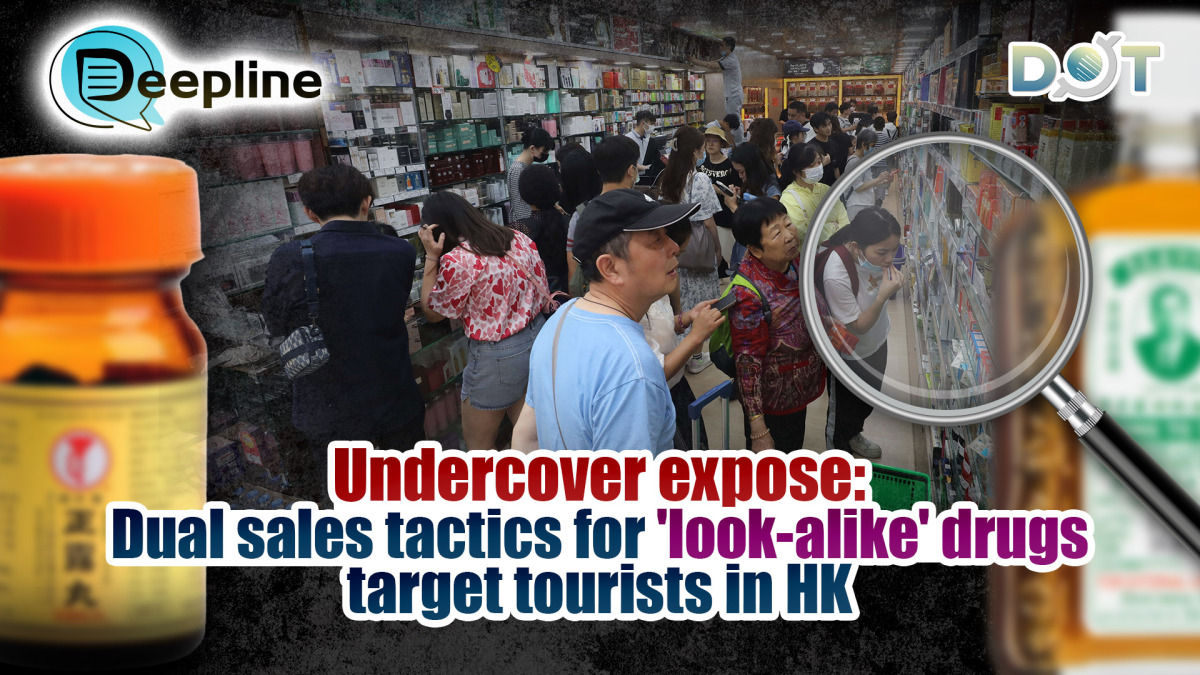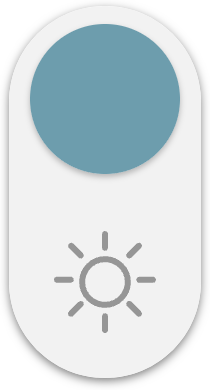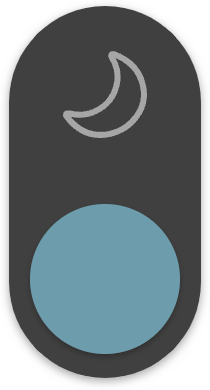
"Look-alike drugs" generally refer to pharmaceutical products whose packaging design or name plagiarizes certain well-known drug brands, yet with slight differences, while the product's content and active ingredients are completely different from the genuine article. They are a type of medication that walks the line between knock-offs and counterfeits, attempting to confuse consumers.
For many years, Hong Kong laws have lacked regulation for look-alike drugs. As long as the packaging design and trademark differ from the genuine product, even if only slightly, it is difficult to convict for copyright infringement. If manufacturers add an edible ingredient to the product, it can even be freely sold as a "health product," evading restrictions from pharmaceutical-related laws.
With the National Day holiday approaching, to enhance tourists' "immunity" against counterfeits, Wen Wei Po reporters recently posed as residents or tourists to inspect over ten pharmacies in Tsim Sha Tsui and Causeway Bay. A rough estimate revealed more than twenty types of drugs that mimic well-known medications.
Three household over-the-counter drugs were the most frequently copied, with one cough medicine having six or seven different look-alike versions. Their packaging and names were almost identical, making it difficult to distinguish genuine from fake at a glance. However, the Trade Descriptions Ordinance, which serves as the final safeguard, contains "gray areas."
Unscrupulous pharmacy staff know how to use "verbal deception" to circumvent the law, broadly categorized into four deceptive sales tactics. It was also discovered that pharmacy staff employ distinctly different tactics to evade the law when promoting to Cantonese-speaking versus Mandarin-speaking customers.
Tactic 1: Pretending to be different regional versions, but actually being counterfeit goods
The most common method used by look-alike drugs to confuse consumers is displaying packaging entirely in foreign languages, pretending to be versions sold in the country of origin. During the investigation, one Wen Wei Po reporter posed as a mainland tourist and spoke Mandarin to a male staff member, expressing a desire to buy MUHI. After glancing at and sizing up the reporter, the staff member promptly placed the product on the glass counter. The reporter picked it up for inspection; at first glance, the product looked similar to the genuine article, with confusingly similar packaging colors and design. Upon closer inspection, it was found that the entire packaging lacked any Chinese characters, a clear difference from the genuine Hong Kong product, which bears the three Chinese characters for "MUHI." It was priced at HK$45, which was HK$10 more expensive than the genuine "MUHI" in large chain stores in the same area.
The reporter then asked the staff, "Is this MUHI?" The staff replied, "Yes." The reporter further asked, "Why are there no Chinese characters for 'MUHI'?" The staff casually responded, "The original Japanese version is like this." Upon examining the packaging more carefully, the reporter noticed the clue: the genuine product's brand English name is "MUHI," while this look-alike product was "MUBI." It also lacked a Department of Health registration number, confirming it was not genuine.
Doreen Kong, a Lawyer and Legislative Council member, noted that selling genuine parallel imports in Hong Kong is not illegal. However, any drug sold in Hong Kong must be registered. Therefore, even if foreign versions are registered or legally sold in their country of origin, they still need to be re-registered in Hong Kong.
Superficially pretending to be different regional versions, they are actually counterfeit goods of unknown origin. Close observation of this counterfeit's packaging revealed small Japanese text stating "non-pharmaceutical." However, the genuine MUHI is classified as a Category 2 pharmaceutical in Japan and should not bear the words "non-pharmaceutical." This counterfeit drug, with its all-Japanese description and highly imitative packaging design, can easily deceive tourists unfamiliar with Hong Kong laws.
Tactic 2: Drug names sounding similar to genuine products or using the "misheard pronunciation" defense
Even a slight difference in the pronunciation of a look-alike drug's name can become a defense for staff to evade legal oversight during sales. After confirming that the "Japanese version MUHI" with the English drug name "MUBI" was not genuine but a look-alike, the Mandarin-speaking undercover reporter decided to purchase it and requested an invoice. The receipt listed the drug name not as "MUHI" but as "MUBI."
Furthermore, the English pronunciation of the look-alike drug "MUBI" is similar to the Cantonese pronunciation of "MUHI." Consumers unaware that the genuine "MUHI"'s English name is "MUHI" are very easily tricked.
When the reporter stated in Mandarin wanting to buy "MUHI," the staff provided a look-alike with a similar name. If pursued, the staff could defend themselves by claiming their Mandarin wasn't fluent and they misheard the request for "MUHI," thus avoiding violation of the Trade Descriptions Ordinance. If staff use mishearing as a defense, they are packaging intentional misleading as "carelessness" or "inadvertence," which falls far short of the "intent to deceive" required for prosecuting unfair sales practices, making conviction difficult.
Tactic 3: Slight differences in drug names misleading tourists unfamiliar with traditional characters
Even a single character difference in the trademark or name of a look-alike drug can mislead tourists less familiar with traditional Chinese characters. During one investigation, upon entering a store, the reporter immediately saw displays of several look-alikes of well-known drugs. To Hong Kong people familiar with traditional characters and brand names, these names are distinctly different. But in the perception of tourists, who might only roughly remember the pronunciation of the prestigious name, these names might all look similar at a glance.
Since the shop window displayed two look-alike drugs simultaneously, the reporter asked in Mandarin about the difference between the two. The female staff claimed the former was a family pack, while the other was suspected to be a convenient pack for carrying out. The reporter picked up both for careful examination, confirmed they were not produced by the genuine manufacturer, and deliberately asked, "Is this one the 'most authentic'?" Upon hearing this, the female staff did not respond immediately. After a moment's hesitation, she retrieved the genuine product from under the counter and said, "This one is expensive, over HK$700 per pack."
The price of the genuine product was 70-80% higher than in other large chain stores.
Tactic 4: Misleading through trademark logos
Besides drug names, trademark logos can also be misleading and serve as a shield for staff to evade legal oversight. Later, another reporter speaking Cantonese entered the same health and beauty store. On the shelf was a product mimicking "Seirogan (Trumpet Brand)." Its box design and color were almost identical to the genuine product, but careful observation revealed two extra characters on the design.
The orientation of the trumpet trademark also differed from the genuine article: the curve of the genuine product's trumpet pattern faced left, while the look-alike's trumpet trademark curved to the right. The price of the look-alike was nearly 70% higher than the genuine product, with the small bottle costing HK$98 and the large bottle HK$198.
Journalist's View | Problematic shops often are not government-registered dispensaries
By Guangji
This extensive undercover operation gave the reporter deep insight into the sales skills of pharmacy staff in assessing people, applying double standards to locals and tourists. When reporters posed as mainland tourists speaking Mandarin to purchase medicine, staff brazenly promoted look-alike drugs, using various excuses to circumvent the law.
However, when reporters used Cantonese to buy medicine as locals, staff, understanding that locals are harder to deceive, became cautious in selling look-alikes or changed their tactics, selling parallel imports of unknown origin—Japanese versions, Thai versions... all were brought out, and they could even charge exorbitant prices.
The reporter's investigation also found that pharmacy types vary widely. Shops employing unfair sales practices are mostly non-government-registered dispensaries (℞), such as health and beauty stores or "medicine workshops." These are merely ordinary shops. One store's sign claimed: "Government Registered, Confidence Guaranteed, Duty-Free Genuine Goods." However, upon entering, numerous look-alike drugs were displayed, and this store was also not a registered dispensary.
(Source: Wen Wei Po; Journalist: Guangji, Zeng; English Editor: Darius)
Related News:
Journalist's View | Herbal medicine trick in HK: Tourists beware of deceptive pharmacy practices




















Comment